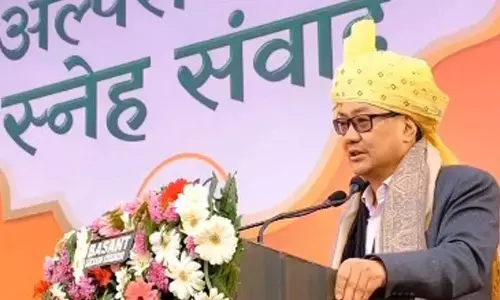Authentic weaves masked by fakes
Most handloom weavers, who are the creators of Benares’ beautiful weaves admired all over the world feel that concessions extended by the government with regard to electricity and other benefits are all aimed at the power loom sector and there is no policy to revive handlooms whose numbers have come down drastically in the last decade
The road leading to the famous Kashi Vishwanath temple in Benares is sealed off for vehicles and one has to wade through the main market dotted by shops on either side before getting into the narrow by lanes that take you there.
Two kinds of glib talking agents are omnipresent in this market place; the ones promising a quick temple darshan and those from wholesale shops telling you where you get the best Benarasi sarees for the most reasonable prices.
It is in the congested lanes of Bara bazaar, Peeli kothi and Kunj gali teeming with wholesale and retail shops that you discover yards of material and sarees where Benarasi motifs and weaves dazzle your eyes.
But sadly, the world-famous Benares saree known for the richness of its drape and the intricacy of its weave may soon become a thing of the past. Very few weaver families are still sticking to this craft and those that are have shifted to power looms.
Faced with unfair competition many weavers are plying rickshaws, running tea stalls or working as boatmen while those remaining, prefer the more lucrative power looms where sarees can be churned out with great speed and less effort.
"What authentic Benarasi work? There is nothing like that anymore. We have the original motifs, designs and colours but on power looms which have replaced handlooms.
They look so authentic; you just can't tell the difference between the two unless you are an expert," says Mohammed Ansari, who sells sarees ranging from Rs 1500 to 2.5 lakhs in his two-storey shop here. It's not just the loom. The quality of the fabric too has changed with cheap Chinese silk, art silk and other polyester mixed sarees replacing the lustrous silk of yesteryear. "We have no option but to change with the times otherwise how will we do business?" Ansari asks.
The smaller shops in the market whose agents are scouting for customers have even cheaper variants with flower motifs on the gold zaris shining a tad too brightly for as low as Rs 300.
"There are no weavers in Benares anymore. We only have traders selling power loom sarees," declares Ajay, a former weaver-turned-tourist guide. The Benares story is the all too familiar tale of tragedy where weavers in post-independent India, are seeing large scale disruption in the form of machines that are destroying age-old crafts and livelihoods.
Works of extraordinary beauty and exquisite skill, each saree weaved on the handloom takes 15 days or more to make if all members of the weaver's family including the women and children, work eight hours per day.
Less than 10 per cent of the weaver community is working on handlooms today as power looms are able to come out with designs very similar to handlooms at half the price and greater speed.
"We use more than 6,000 threads in some of our Benares saree using the phekwa, and kadwa work typical to this place. In kadwa weaving, each motif is woven separately and there are no loose threads at the back of the fabric.
Only 7 to 9 families from villages around the city are capable of this kind of work where designs are created on the spot by the weaver. A heavy saree with elaborate floral motifs and bootas can take up to 25 days to complete," informs Zubair Ahmad Ansari of Silk Khazana near the cantonment area of Varanasi.
This outlet is one of the few places in the city that continue to make some of the authentic Benares sarees sought by select clientele.
Exquisite tapestry work embellished with gold, silver and silken threads in different colours is also a rare and sought-after craft of the Benares weave. Benarasi work is replete with resplendent masterpieces that stand out for their sheer elegance and workmanship.
Most handloom weavers, who are the creators of these beautiful weaves admired all over the world feel that concessions extended by the government with regard to electricity and other benefits are all aimed at the power loom sector and there is no policy to revive handlooms whose numbers have come down drastically in the last decade.
To protect the legacy reflected by silken threads and golden weaves should become a priority both for the government and concerned citizens. Let us not watch helplessly the death of a glorious tradition.

















